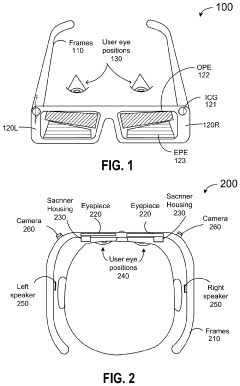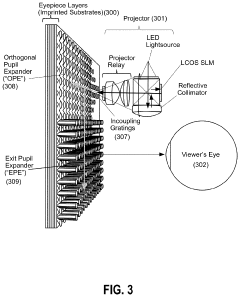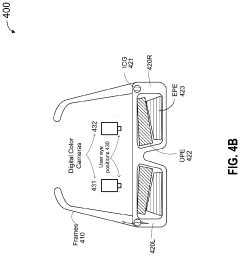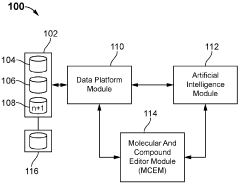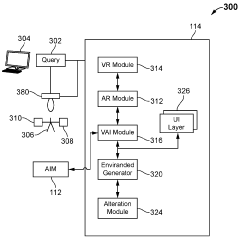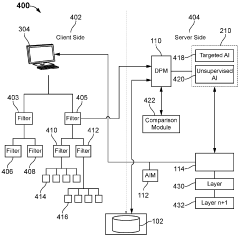Exploring virtual reality enhancements with silicon photonics.
JUL 17, 20259 MIN READ
Generate Your Research Report Instantly with AI Agent
Patsnap Eureka helps you evaluate technical feasibility & market potential.
VR and Silicon Photonics Background
Virtual Reality (VR) has emerged as a transformative technology, revolutionizing how we interact with digital environments. Concurrently, silicon photonics has been making significant strides in the field of integrated optics. The convergence of these two technologies presents exciting opportunities for enhancing VR experiences.
VR technology has its roots in the 1960s, with early prototypes like Ivan Sutherland's "Sword of Damocles." However, it wasn't until the 2010s that VR began to gain mainstream traction, driven by advancements in display technology, computing power, and motion tracking. Today's VR systems offer immersive experiences across various applications, from gaming and entertainment to education and professional training.
Despite the progress, current VR technology faces several challenges. These include limited field of view, motion sickness, and the need for more realistic visual experiences. Additionally, the bulk and weight of VR headsets often hinder user comfort and prolonged use. These limitations have spurred research into novel technologies that can address these issues and push VR capabilities further.
Silicon photonics, on the other hand, is a relatively newer field that has gained momentum in the past two decades. It involves the use of silicon as an optical medium to manipulate light for various applications. The technology leverages the well-established semiconductor manufacturing processes, making it cost-effective and scalable. Silicon photonics has found applications in data centers, telecommunications, and sensing technologies.
The potential synergy between VR and silicon photonics lies in the latter's ability to manipulate light with unprecedented precision and efficiency. This capability could be harnessed to develop more advanced display technologies for VR headsets, potentially addressing issues such as resolution, refresh rate, and power consumption. Moreover, silicon photonics could enable the integration of complex optical systems into compact form factors, potentially leading to lighter and more comfortable VR devices.
As we explore the intersection of VR and silicon photonics, it's important to consider the broader technological landscape. Advancements in related fields such as 5G networks, edge computing, and artificial intelligence are likely to complement and accelerate innovations in VR and silicon photonics. This convergence of technologies could pave the way for more immersive, responsive, and realistic virtual experiences.
The journey of enhancing VR with silicon photonics is still in its early stages, with significant research and development required to fully realize its potential. However, the promise of this integration has already attracted attention from both academia and industry, signaling a growing recognition of its transformative potential in the realm of immersive technologies.
VR technology has its roots in the 1960s, with early prototypes like Ivan Sutherland's "Sword of Damocles." However, it wasn't until the 2010s that VR began to gain mainstream traction, driven by advancements in display technology, computing power, and motion tracking. Today's VR systems offer immersive experiences across various applications, from gaming and entertainment to education and professional training.
Despite the progress, current VR technology faces several challenges. These include limited field of view, motion sickness, and the need for more realistic visual experiences. Additionally, the bulk and weight of VR headsets often hinder user comfort and prolonged use. These limitations have spurred research into novel technologies that can address these issues and push VR capabilities further.
Silicon photonics, on the other hand, is a relatively newer field that has gained momentum in the past two decades. It involves the use of silicon as an optical medium to manipulate light for various applications. The technology leverages the well-established semiconductor manufacturing processes, making it cost-effective and scalable. Silicon photonics has found applications in data centers, telecommunications, and sensing technologies.
The potential synergy between VR and silicon photonics lies in the latter's ability to manipulate light with unprecedented precision and efficiency. This capability could be harnessed to develop more advanced display technologies for VR headsets, potentially addressing issues such as resolution, refresh rate, and power consumption. Moreover, silicon photonics could enable the integration of complex optical systems into compact form factors, potentially leading to lighter and more comfortable VR devices.
As we explore the intersection of VR and silicon photonics, it's important to consider the broader technological landscape. Advancements in related fields such as 5G networks, edge computing, and artificial intelligence are likely to complement and accelerate innovations in VR and silicon photonics. This convergence of technologies could pave the way for more immersive, responsive, and realistic virtual experiences.
The journey of enhancing VR with silicon photonics is still in its early stages, with significant research and development required to fully realize its potential. However, the promise of this integration has already attracted attention from both academia and industry, signaling a growing recognition of its transformative potential in the realm of immersive technologies.
Market Analysis for VR Enhancement
The virtual reality (VR) market has been experiencing significant growth and transformation, driven by technological advancements and increasing consumer adoption. The integration of silicon photonics into VR systems presents a promising opportunity to enhance the overall user experience and expand the market potential for VR applications.
The global VR market size was valued at $21.83 billion in 2021 and is projected to reach $84.09 billion by 2028, growing at a CAGR of 25.3% during the forecast period. This growth is fueled by the increasing demand for VR technology across various sectors, including gaming, entertainment, education, healthcare, and enterprise applications.
Silicon photonics technology has the potential to address several key challenges in VR systems, particularly in terms of display quality, data transmission, and power efficiency. By leveraging the advantages of silicon photonics, VR headsets can achieve higher resolution displays, reduced latency, and improved overall performance, which are critical factors for enhancing user immersion and comfort.
The gaming and entertainment sectors currently dominate the VR market, accounting for approximately 40% of the total market share. However, the integration of silicon photonics is expected to open up new opportunities in other sectors, such as healthcare and education, where high-fidelity visual experiences are crucial for training and simulation purposes.
The enterprise sector is also showing significant interest in VR technology enhanced by silicon photonics. Companies are increasingly adopting VR solutions for remote collaboration, product design, and employee training. The improved visual quality and reduced form factor made possible by silicon photonics are likely to accelerate this trend, potentially expanding the enterprise VR market by 30% over the next five years.
Geographically, North America leads the VR market, followed by Asia-Pacific and Europe. The adoption of silicon photonics in VR is expected to be particularly strong in regions with advanced semiconductor industries, such as the United States, China, and South Korea. These regions are likely to see the earliest integration of silicon photonics into VR systems, potentially capturing a larger market share in the coming years.
Consumer demand for more immersive and realistic VR experiences is driving the need for higher resolution displays and faster data processing. Silicon photonics can enable VR headsets to support 8K or even 16K resolution per eye, a significant improvement over current 4K standards. This enhancement is expected to increase the average selling price of high-end VR headsets by 15-20%, creating a new premium segment in the market.
The integration of silicon photonics in VR is also anticipated to reduce the overall power consumption of VR systems by up to 30%, addressing one of the major limitations of current VR technology. This improvement in energy efficiency could lead to longer battery life and more comfortable, lightweight designs, potentially expanding the user base for mobile VR applications by 25% within the next three years.
The global VR market size was valued at $21.83 billion in 2021 and is projected to reach $84.09 billion by 2028, growing at a CAGR of 25.3% during the forecast period. This growth is fueled by the increasing demand for VR technology across various sectors, including gaming, entertainment, education, healthcare, and enterprise applications.
Silicon photonics technology has the potential to address several key challenges in VR systems, particularly in terms of display quality, data transmission, and power efficiency. By leveraging the advantages of silicon photonics, VR headsets can achieve higher resolution displays, reduced latency, and improved overall performance, which are critical factors for enhancing user immersion and comfort.
The gaming and entertainment sectors currently dominate the VR market, accounting for approximately 40% of the total market share. However, the integration of silicon photonics is expected to open up new opportunities in other sectors, such as healthcare and education, where high-fidelity visual experiences are crucial for training and simulation purposes.
The enterprise sector is also showing significant interest in VR technology enhanced by silicon photonics. Companies are increasingly adopting VR solutions for remote collaboration, product design, and employee training. The improved visual quality and reduced form factor made possible by silicon photonics are likely to accelerate this trend, potentially expanding the enterprise VR market by 30% over the next five years.
Geographically, North America leads the VR market, followed by Asia-Pacific and Europe. The adoption of silicon photonics in VR is expected to be particularly strong in regions with advanced semiconductor industries, such as the United States, China, and South Korea. These regions are likely to see the earliest integration of silicon photonics into VR systems, potentially capturing a larger market share in the coming years.
Consumer demand for more immersive and realistic VR experiences is driving the need for higher resolution displays and faster data processing. Silicon photonics can enable VR headsets to support 8K or even 16K resolution per eye, a significant improvement over current 4K standards. This enhancement is expected to increase the average selling price of high-end VR headsets by 15-20%, creating a new premium segment in the market.
The integration of silicon photonics in VR is also anticipated to reduce the overall power consumption of VR systems by up to 30%, addressing one of the major limitations of current VR technology. This improvement in energy efficiency could lead to longer battery life and more comfortable, lightweight designs, potentially expanding the user base for mobile VR applications by 25% within the next three years.
Current Challenges in VR Technology
Virtual reality (VR) technology has made significant strides in recent years, but several challenges persist in delivering a truly immersive and seamless user experience. One of the primary obstacles is the limitation of current display technologies, which struggle to match the resolution and field of view of human vision. This discrepancy can lead to the "screen door effect," where users perceive visible gaps between pixels, detracting from the overall immersion.
Another significant challenge is the issue of motion sickness and discomfort experienced by many users during prolonged VR sessions. This problem stems from the disconnect between visual stimuli and the user's physical movements, often exacerbated by latency in image rendering and display. Reducing this latency while maintaining high-quality visuals remains a complex technical hurdle.
The development of more intuitive and natural user interfaces presents another ongoing challenge. Current VR systems often rely on handheld controllers or limited gesture recognition, which can feel cumbersome and break the sense of presence in virtual environments. Creating more seamless interaction methods that closely mimic real-world actions is crucial for enhancing user engagement and expanding VR applications.
Power consumption and heat generation are additional concerns, particularly for standalone VR devices. The need for high-performance processors and displays conflicts with the desire for lightweight, comfortable headsets with extended battery life. Balancing these competing requirements while maintaining performance is a delicate engineering challenge.
Content creation for VR also poses significant difficulties. Developing high-quality, immersive content requires specialized skills and tools, which can be costly and time-consuming. This bottleneck in content production limits the variety and quality of VR experiences available to users, potentially slowing widespread adoption.
Lastly, the challenge of social interaction in VR environments remains largely unsolved. While VR has the potential to revolutionize remote collaboration and social experiences, current technologies struggle to accurately convey nuanced facial expressions, body language, and other non-verbal cues that are crucial for natural human interaction. Overcoming this limitation is essential for realizing the full potential of VR in social and professional contexts.
Addressing these challenges requires interdisciplinary approaches, combining advancements in optics, display technology, computer graphics, sensor technology, and human-computer interaction. The integration of emerging technologies like silicon photonics offers promising avenues for overcoming some of these obstacles, potentially leading to more immersive, comfortable, and widely accessible VR experiences in the future.
Another significant challenge is the issue of motion sickness and discomfort experienced by many users during prolonged VR sessions. This problem stems from the disconnect between visual stimuli and the user's physical movements, often exacerbated by latency in image rendering and display. Reducing this latency while maintaining high-quality visuals remains a complex technical hurdle.
The development of more intuitive and natural user interfaces presents another ongoing challenge. Current VR systems often rely on handheld controllers or limited gesture recognition, which can feel cumbersome and break the sense of presence in virtual environments. Creating more seamless interaction methods that closely mimic real-world actions is crucial for enhancing user engagement and expanding VR applications.
Power consumption and heat generation are additional concerns, particularly for standalone VR devices. The need for high-performance processors and displays conflicts with the desire for lightweight, comfortable headsets with extended battery life. Balancing these competing requirements while maintaining performance is a delicate engineering challenge.
Content creation for VR also poses significant difficulties. Developing high-quality, immersive content requires specialized skills and tools, which can be costly and time-consuming. This bottleneck in content production limits the variety and quality of VR experiences available to users, potentially slowing widespread adoption.
Lastly, the challenge of social interaction in VR environments remains largely unsolved. While VR has the potential to revolutionize remote collaboration and social experiences, current technologies struggle to accurately convey nuanced facial expressions, body language, and other non-verbal cues that are crucial for natural human interaction. Overcoming this limitation is essential for realizing the full potential of VR in social and professional contexts.
Addressing these challenges requires interdisciplinary approaches, combining advancements in optics, display technology, computer graphics, sensor technology, and human-computer interaction. The integration of emerging technologies like silicon photonics offers promising avenues for overcoming some of these obstacles, potentially leading to more immersive, comfortable, and widely accessible VR experiences in the future.
Existing VR Enhancement Solutions
01 Integration of silicon photonics in VR displays
Silicon photonics technology is being integrated into virtual reality displays to enhance image quality and reduce form factor. This approach utilizes silicon-based optical components to manipulate light, potentially improving resolution, brightness, and energy efficiency in VR headsets.- Integration of silicon photonics in VR displays: Silicon photonics technology is being integrated into virtual reality displays to enhance image quality and reduce form factor. This approach utilizes silicon-based optical components to manipulate light, potentially improving resolution, brightness, and energy efficiency in VR headsets.
- Eye-tracking systems using silicon photonics: Advanced eye-tracking systems for VR are being developed using silicon photonic components. These systems can provide more accurate and responsive eye movement detection, enabling better user interaction and potentially reducing motion sickness in virtual environments.
- Haptic feedback enhancement with silicon photonics: Silicon photonics is being utilized to improve haptic feedback in VR systems. This technology allows for more precise and realistic tactile sensations, enhancing the immersive experience in virtual environments by providing users with a sense of touch and texture.
- Improved data transmission for VR using silicon photonics: Silicon photonics is being employed to enhance data transmission in VR systems. This technology enables faster and more efficient data transfer between VR components, potentially reducing latency and improving overall system performance for a more seamless user experience.
- Silicon photonics-based 3D sensing for VR: 3D sensing technologies utilizing silicon photonics are being developed for VR applications. These advancements can improve depth perception, object recognition, and spatial mapping in virtual environments, leading to more accurate and immersive VR experiences.
02 Eye-tracking systems using silicon photonics
Advanced eye-tracking systems for VR are being developed using silicon photonic components. These systems can provide more accurate and responsive eye movement detection, enabling better user interaction and potentially reducing motion sickness in virtual environments.Expand Specific Solutions03 Photonic interconnects for VR data transmission
Silicon photonic interconnects are being utilized to enhance data transmission in VR systems. This technology allows for higher bandwidth and lower latency communication between VR components, potentially improving overall system performance and user experience.Expand Specific Solutions04 Silicon photonic sensors for VR input devices
Silicon photonic sensors are being incorporated into VR input devices to enhance user interaction. These sensors can provide more precise and responsive control mechanisms, potentially improving the immersive experience in virtual environments.Expand Specific Solutions05 Photonic neural networks for VR processing
Silicon photonic neural networks are being explored for VR applications to enhance real-time processing capabilities. This technology could potentially improve graphics rendering, physics simulations, and AI-driven interactions within virtual environments.Expand Specific Solutions
Key Players in VR and Photonics
The virtual reality (VR) enhancement market using silicon photonics is in a growth phase, with increasing market size and technological advancements. The global VR market is projected to expand significantly, driven by applications in gaming, healthcare, and enterprise sectors. Key players like Magic Leap, Intel, and Apple are investing heavily in silicon photonics for VR, focusing on improving display resolution, reducing latency, and enhancing overall user experience. Companies such as Applied Materials and Fraunhofer-Gesellschaft are contributing to the development of advanced manufacturing processes and materials for silicon photonics in VR applications. As the technology matures, we can expect more compact, efficient, and immersive VR devices leveraging silicon photonics capabilities.
Intel Corp.
Technical Solution: Intel is developing silicon photonics technology for virtual reality applications, focusing on high-bandwidth, low-latency data transmission. Their approach integrates photonic components directly onto silicon chips, enabling faster data processing and reduced power consumption. Intel's silicon photonics solution achieves data rates up to 400 Gbps[1], significantly enhancing VR performance. They are also exploring the use of wavelength division multiplexing (WDM) to further increase bandwidth capacity, potentially reaching terabit-per-second speeds in the near future[2]. Intel's technology aims to address the high-bandwidth requirements of next-generation VR headsets, reducing motion-to-photon latency and improving overall user experience.
Strengths: Industry-leading silicon fabrication capabilities, extensive R&D resources, and established partnerships in the VR ecosystem. Weaknesses: Potential challenges in miniaturization for compact VR devices and competition from specialized photonics companies.
Apple, Inc.
Technical Solution: Apple is leveraging silicon photonics to enhance its virtual reality and augmented reality initiatives. The company is developing custom silicon solutions that integrate photonic circuits for high-speed data processing and low-latency display technologies. Apple's approach focuses on miniaturizing photonic components to fit within sleek, consumer-friendly devices. Their silicon photonics technology is expected to enable foveated rendering, which could significantly reduce the computational load on VR/AR systems by focusing high-resolution rendering only where the user is looking[3]. Additionally, Apple is exploring the use of silicon photonics for advanced eye-tracking and gesture recognition, potentially revolutionizing user interfaces in virtual environments[4].
Strengths: Strong integration of hardware and software, extensive consumer electronics experience, and a robust ecosystem. Weaknesses: Less public disclosure of specific technologies, potential limitations in specialized photonics expertise compared to dedicated photonics firms.
Silicon Photonics Innovations for VR
Method and system for color calibration of an imaging device
PatentActiveUS20210215536A1
Innovation
- A method and system utilizing a low-cost digital color camera to characterize and calibrate wearable AR devices by converting RGB values to absolute color spaces like CIE XYZ, using narrowband light sources and waveguide optics with diffractive structures, and applying conversion models generated through regression methods to ensure uniform chromaticity and luminance across the field of view.
System and method for predictive candidate compound discovery
PatentWO2023141345A1
Innovation
- An AI-assisted system that gathers and processes data on physical, chemical, electrical, genetic, atomic, and sub-atomic dimensions of molecules and compounds, using virtual or augmented reality for interactive visualization and predictive analysis to simulate molecular interactions and identify potential compounds for clinical success.
Regulatory Framework for VR Technologies
The regulatory framework for virtual reality (VR) technologies, particularly those enhanced by silicon photonics, is still evolving as the technology rapidly advances. Currently, there is no comprehensive global regulatory structure specifically tailored to VR technologies. However, existing regulations in related fields are being adapted and applied to address the unique challenges posed by VR.
In the United States, the Federal Communications Commission (FCC) oversees the allocation of radio frequency spectrum, which is crucial for wireless VR devices. The Food and Drug Administration (FDA) may also play a role in regulating VR devices used for medical applications. The Consumer Product Safety Commission (CPSC) is responsible for ensuring the safety of consumer VR products.
In the European Union, the General Data Protection Regulation (GDPR) has significant implications for VR technologies, especially concerning user privacy and data protection. The EU's Artificial Intelligence Act, currently under development, may also impact VR systems that incorporate AI components.
Specific to silicon photonics in VR, regulatory bodies such as the International Electrotechnical Commission (IEC) and the Institute of Electrical and Electronics Engineers (IEEE) are working on standards for optical components and systems. These standards will likely influence the development and implementation of silicon photonics in VR devices.
Safety regulations are a critical aspect of the VR regulatory framework. Concerns about potential health impacts, such as eye strain, motion sickness, and long-term neurological effects, are driving the development of safety guidelines. The International Organization for Standardization (ISO) has published standards for VR and augmented reality (AR) systems, addressing issues like visual comfort and user safety.
Intellectual property regulations also play a significant role in the VR ecosystem. Patent offices worldwide are grappling with the unique challenges posed by VR and related technologies, leading to evolving guidelines for patent applications in this field.
As VR technologies become more immersive and integrated into daily life, ethical considerations are increasingly important. Several countries and organizations are developing ethical guidelines for VR development and use, addressing issues such as user consent, psychological impact, and potential addiction.
The regulatory landscape for VR technologies enhanced by silicon photonics is likely to continue evolving rapidly. Policymakers, industry leaders, and researchers must collaborate to create a balanced regulatory framework that promotes innovation while protecting users and addressing societal concerns.
In the United States, the Federal Communications Commission (FCC) oversees the allocation of radio frequency spectrum, which is crucial for wireless VR devices. The Food and Drug Administration (FDA) may also play a role in regulating VR devices used for medical applications. The Consumer Product Safety Commission (CPSC) is responsible for ensuring the safety of consumer VR products.
In the European Union, the General Data Protection Regulation (GDPR) has significant implications for VR technologies, especially concerning user privacy and data protection. The EU's Artificial Intelligence Act, currently under development, may also impact VR systems that incorporate AI components.
Specific to silicon photonics in VR, regulatory bodies such as the International Electrotechnical Commission (IEC) and the Institute of Electrical and Electronics Engineers (IEEE) are working on standards for optical components and systems. These standards will likely influence the development and implementation of silicon photonics in VR devices.
Safety regulations are a critical aspect of the VR regulatory framework. Concerns about potential health impacts, such as eye strain, motion sickness, and long-term neurological effects, are driving the development of safety guidelines. The International Organization for Standardization (ISO) has published standards for VR and augmented reality (AR) systems, addressing issues like visual comfort and user safety.
Intellectual property regulations also play a significant role in the VR ecosystem. Patent offices worldwide are grappling with the unique challenges posed by VR and related technologies, leading to evolving guidelines for patent applications in this field.
As VR technologies become more immersive and integrated into daily life, ethical considerations are increasingly important. Several countries and organizations are developing ethical guidelines for VR development and use, addressing issues such as user consent, psychological impact, and potential addiction.
The regulatory landscape for VR technologies enhanced by silicon photonics is likely to continue evolving rapidly. Policymakers, industry leaders, and researchers must collaborate to create a balanced regulatory framework that promotes innovation while protecting users and addressing societal concerns.
Environmental Impact of Silicon Photonics in VR
The integration of silicon photonics in virtual reality (VR) systems presents both opportunities and challenges from an environmental perspective. As this technology advances, it is crucial to consider its ecological footprint and potential sustainability benefits. Silicon photonics offers the promise of more energy-efficient data processing and transmission, which could significantly reduce the power consumption of VR devices. This efficiency gain is particularly important given the increasing computational demands of immersive VR experiences.
The manufacturing process of silicon photonic components, however, requires careful scrutiny. While silicon is abundant, the production of high-purity silicon wafers and the fabrication of photonic circuits involve energy-intensive processes and potentially harmful chemicals. The environmental impact of these manufacturing steps must be weighed against the long-term energy savings and performance improvements they enable in VR systems.
One of the most significant environmental benefits of silicon photonics in VR could be the reduction of electronic waste. By enabling more compact and durable VR hardware, silicon photonics may extend the lifespan of devices and reduce the frequency of replacements. This could lead to a decrease in the overall volume of electronic waste generated by the VR industry, which is particularly important given the rapid pace of technological advancement in this field.
The use of silicon photonics may also contribute to the miniaturization of VR devices, potentially reducing the amount of materials required for their production. This could lead to a decrease in resource extraction and associated environmental impacts. Additionally, smaller devices typically require less packaging, further reducing waste and transportation-related emissions.
From a lifecycle perspective, the environmental impact of silicon photonics in VR extends beyond manufacturing and use. The recyclability and end-of-life management of these components must be considered. While silicon itself is recyclable, the complex integration of photonic circuits with other electronic components may pose challenges for efficient recycling processes. Developing effective recycling methods for these advanced devices will be crucial to minimizing their long-term environmental impact.
As VR technology becomes more widespread, the energy consumption of data centers supporting these immersive experiences is a growing concern. Silicon photonics could play a vital role in improving the energy efficiency of data transmission and processing in these facilities, potentially mitigating the increased power demands associated with the growth of VR applications.
The manufacturing process of silicon photonic components, however, requires careful scrutiny. While silicon is abundant, the production of high-purity silicon wafers and the fabrication of photonic circuits involve energy-intensive processes and potentially harmful chemicals. The environmental impact of these manufacturing steps must be weighed against the long-term energy savings and performance improvements they enable in VR systems.
One of the most significant environmental benefits of silicon photonics in VR could be the reduction of electronic waste. By enabling more compact and durable VR hardware, silicon photonics may extend the lifespan of devices and reduce the frequency of replacements. This could lead to a decrease in the overall volume of electronic waste generated by the VR industry, which is particularly important given the rapid pace of technological advancement in this field.
The use of silicon photonics may also contribute to the miniaturization of VR devices, potentially reducing the amount of materials required for their production. This could lead to a decrease in resource extraction and associated environmental impacts. Additionally, smaller devices typically require less packaging, further reducing waste and transportation-related emissions.
From a lifecycle perspective, the environmental impact of silicon photonics in VR extends beyond manufacturing and use. The recyclability and end-of-life management of these components must be considered. While silicon itself is recyclable, the complex integration of photonic circuits with other electronic components may pose challenges for efficient recycling processes. Developing effective recycling methods for these advanced devices will be crucial to minimizing their long-term environmental impact.
As VR technology becomes more widespread, the energy consumption of data centers supporting these immersive experiences is a growing concern. Silicon photonics could play a vital role in improving the energy efficiency of data transmission and processing in these facilities, potentially mitigating the increased power demands associated with the growth of VR applications.
Unlock deeper insights with Patsnap Eureka Quick Research — get a full tech report to explore trends and direct your research. Try now!
Generate Your Research Report Instantly with AI Agent
Supercharge your innovation with Patsnap Eureka AI Agent Platform!
